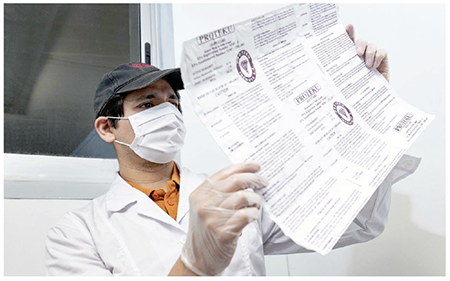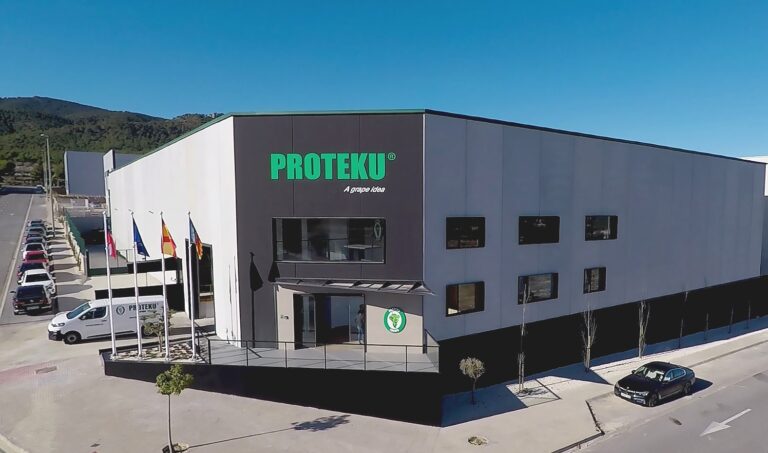In a season that was marked by a prolonged drought, but also by sporadic and severe rainfall, which caused serious damage to production, Infruta continued to provide a rapid response to its clients in Chile and throughout the world, with products of proven efficiency in all markets. This allowed them to successfully finish a complicated campaign, continuing as leaders in the SO2 Generators world market.
Complex and one of the most difficult in recent years. This is how the 2020/21 table grape season in Chile could be defined, a campaign that has been strongly marked by two situations that have marked national production, both in terms of production yields and the quality of the exported fruit. The first of these is the drought that is affecting the north and center of the country, which is jeopardizing the industry. The second, also related to a climatic event, was the strong storm at the end of January, which left heavy rainfall and strong winds, causing significant damage and loss of production and infrastructure.
These severe rainfalls that occurred between January 29 and 31 caused significant losses to the country’s fruit industry, affecting an important area of table grapes, causing in some areas losses of up to 100% of production and the total destruction of some vineyards that still had fruit to harvest.
“The effects of the storm were also visible in the condition and quality of the grapes that were sent to the different markets. We must place special emphasis on shipments destined for the United States, where a considerable part of the fruit suffered substantial price drops and many grapes had to be discarded because they were not of quality or condition for sale. This is something that we were able to observe during our visit to the ports of Wilmington, in Delaware, and Holt, in New Jersey, in the United States, in March of this year”, explains Ricardo Maldonado, Commercial Director of Infruta.

But, in the face of a complicated campaign like the one just passed, how is it possible to minimize the risks, so that a fruit reaches the destination markets in good condition? “The quality of the raw material is vital,” says Ricardo Maldonado, adding that the fruit must be well finished, that is, without color problems, clean, without rot that comes from the field, avoiding damage from handling and scissors during harvesting. harvest. “Harvest and packing times should be as short as possible in order to minimize dehydration and the general condition of the grapes. The use of plastic covers, such as box-to-box metalized hoods or pallet covers are of great help to minimize and reduce dehydration problems due to the delay of the harvested boxes arriving at the packing center”, Maldonado emphasizes.
THE FUNDAMENTALS OF AN ADEQUATE PROTECTION OF TABLE GRAPE
The protection of the fruit is fundamental so that it arrives in optimal conditions to the destination markets. However, it must be done correctly. “For this, it is essential to reinforce the protection of the harvested grapes with the use of stable sulfur dioxide generating devices, which ensure an adequate concentration in the boxes from the first minute the device is placed inside and for as long as necessary , thus allowing the grapes to reach their destination free of rot, with good stems and without bleaching”, explains the Commercial Director of Infruta.
Currently, and in the case of the Chilean table grape industry, the use of SO2 Generators that have ‘double phase’ is crucial and essential. “These are generators that have a ‘fast phase,’ which acts immediately from the closing of the box. Likewise, they have a ‘slow phase’, which works throughout the transport of the grapes to their final destination, and also during the time that they are in the facilities of importers and buyers, especially since in recent years it has increased enormously. the pressure of Botrytis inoculum in the country’s fields”, says the Commercial Director.
“It is essential to reinforce the protection of the harvested grapes with the use of stable sulfur dioxide generating devices, which ensure an adequate concentration in the boxes from the minute one the device is placed inside and for as long as necessary, allowing In this way, the grapes arrive at their destination free of rot, with good stalks and without bleaching”, explains the Commercial Director of Infruta.
To provide optimal protection to the fruit, and ensure that it will remain in good condition, Infruta, through its PROTEKU brand, offers sulfur dioxide devices that allow the grapes to reach their destination in optimal conditions.
“One of them is the use of background generators, especially the BPI, which is a double-phase background generator that acts quickly after the closing of the boxes. This allows immediate gasification, providing multiple benefits during transport and at destination. In addition, the use of larger generators is of vital importance, since they allow better coverage, allowing SO2 to reach all corners of the box with an adequate concentration, which ensures efficient protection of the grapes,” says Katerina Maldonado. , Infruta Marketing Manager.
Likewise, Infruta has developed and manufactured PROTEKU plastic generators of Polypropylene Cells and Laminates, which are the most used in the post-harvest of table grapes in Chile and also in the rest of the producing countries. These are generators that have positioned themselves in the global table grape industry, thanks to the stability they provide in SO2 generation, protecting the fruit and minimizing damage to it.

Regarding the use of SO2 generators, from Infruta they recommend that it is essential to make proper use of them, considering the amount of salt (sodium metabisulfite), the barriers of the generator and its size. Thus, in conditions of high pressure of the Botrytis inoculum in the harvested grapes, it is necessary to protect the grapes evenly in the upper and lower part of the box, for which the use of bottom generators is essential, which allow a equal distribution of SO2 throughout the internal volume of the box. A coverage of at least 70% of the internal area of the box is recommended, both in the surface and in the background generator. In this way, we achieve that the SO2 reaches all corners of the box, especially the corners of the box, which is where rotting usually occurs.
A CHALLENGING SEASON WHERE A QUICK RESPONSE WAS GIVEN TO ALL CUSTOMERS
“This campaign was quite challenging,” says Ricardo Maldonado, since the main challenge was to comply with all the Covid protocols and take care of the company’s workers, giving them all the necessary resources, along with permanent training. “We had no problems and we were able to successfully fulfill all the commitments assumed with our clients, both in Chile and abroad. We concluded a very successful season, continuing as leaders in the world market for SO2 Generators”, underlines the Commercial Director of Infruta.

In order to respond quickly to the needs and requirements of its customers, Infruta has increased its productive capacity with the incorporation of modern, state-of-the-art machinery. “This has been very important and necessary, since, in times of a pandemic, it is essential to streamline production processes and make work more versatile, with the aim of responding more quickly to customer demands and satisfying their needs as far as possible. regarding the quality of the products and deliveries within the required deadlines”, says Cristian Cortés, Operations Manager of Infruta. In addition, the operation and management processes have allowed us to have flexible and efficient systems, responding quickly to the challenges of the current and future competitive environment.
Once the 2020/21 season is over, planning is already underway for 2021/22, which is presumed to also be complex. “We hope that it will not be so in productive terms, but it is forecast to be complex due to an increase in the price of raw materials and maritime freight to and from abroad and its infrequency. This leads us to have to be more efficient in our operations, in order to continue being competitive in the market”, concludes Ricardo Maldonado.






